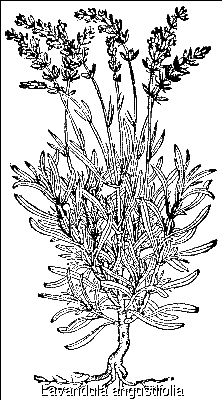LAVENDER
(Lavandula angustifolia)

Appearance
An aromatic shrub-like perennial. It has greyish leaves
and stems. Fragrant purple-blue flowers in long spikes which appear in June
and July.
Habitat
L. angustifolia is the lavender of commerce and is quite widely
cultivated in Cyprus but is not a native of the Eastern Mediterranean
region. It likes to grow in full sunlight, on chalky, well-drained soils.
UsesProperties
Sachets of lavender are commonly used to perfume
clothes and keep moths away. Well known as a medicinal plant since ancient
times and still widely used in Islamic medicine. Used in bath water since
Roman times and indeed the English name may have derived from the Latin
"lavare" (to wash). It is reputed to have excellent tranquillising
effects, inhalation soothing troubled nerves and depression. The
well-known herbalist Culpeper advises it for fainting, headaches, stomach
complaints and many other things. Oil of lavender is an excellent
antiseptic for external use on cuts, burns or bites. Salmons' "Herbal" of
1710 states,"...it is good also against the bitings of serpents, mad dogs
and other venomous creatures...". The oil content of plants growing on
relatively poor soils will be greater. The oil is also widely used in
perfumery. The flowers produce nectar freely this being stored at the
base of the flower protected by a ring of hairs. The flower tube is about
six millimetres long the perfect length for a hive bee. Still widely used
in modern medicine its wide range of properties and versatility making it a
useful domestic remedy for minor ailments and also important in professional
practice.




